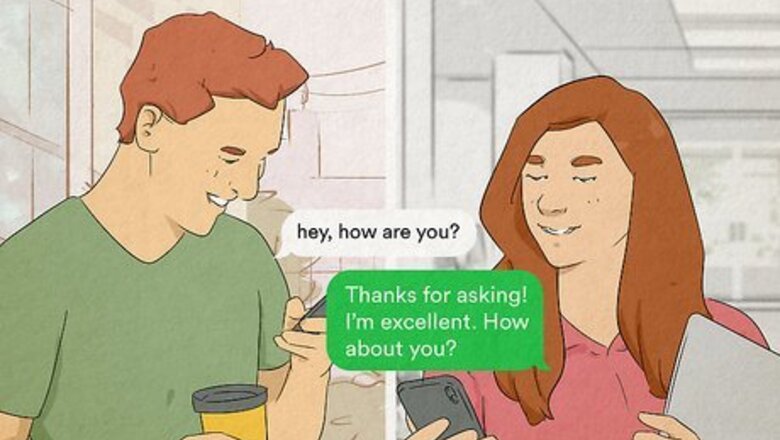
views
To shorten your writing you must use abbreviations. A list of abbreviations are: LOL-laughing out loud, U-you, OK-okay, R-are, Y-why. Here is an example of some of them being used in a sentence. "I saw U fall down yesterday, LOL, also R U OK?"
“Thanks for asking! I’m excellent. How about you?”

Keep it sincere, short, and sweet when you don’t know the person that well. When someone chooses to text you and asks how you’re doing, odds are they really want to know. A meaningful answer with a “thank you” included is best when you simply want the person texting you to know that you appreciate their thinking of you. Similar responses include: “Everything is good, thanks, and I’m loving the rain today!” “Well enough, thank you! I’m looking forward to [an upcoming event]!”
“Not bad, but it’s still early!”

Use humor when you reply to crushes, friends, and people you know well. A more tongue-in-cheek response to the question will make them chuckle, and keep the conversation from getting too serious if you’d also prefer that the tone remains light for the moment. Use any of the following: “I can’t complain, but sometimes I want to anyway!” “You know, according to my lawyer, I don’t have to answer that.” “Medium-well, I’d say.” “Hopefully not as good as I’ll ever be!”
“Better, now that I’m talking to you.”

Be flirty and romantic if it’s your crush or significant other. Texting and checking up on one another is a great way to strengthen your relationship. So, when your crush or partner asks you how you’re doing, let them know that you’re happy to hear from them and appreciate how much they care. Texting is also a great way to deepen an intimate connection with someone by flirting, so try to make your response a little playful and intriguing. “How do you want me to be?” “I’d be better if you were with me.” “Extremely good looking, I’d say!” “Getting better every time you text me.”
“I’m hanging in there.”
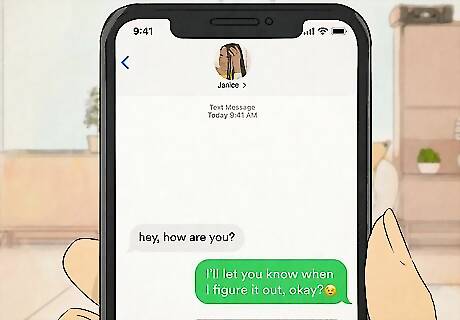
Be honest, even if the answer is “I’m not doing so well.” It’s okay to tell the truth when someone asks you how you’re doing, because lying and saying “I’m great” can feel insincere, and being truthful doesn’t mean you need to dish about everything currently bothering you. Instead, decide how much you want to disclose to the person who is asking. If you want to keep things surface level, “hanging in there,” is a good answer. Explore these other options: “Could be better, could be worse.” “I’ll let you know when I figure it out, okay?” “Well, I’m alive and kicking. You?”
“Great, but I could use some help with…”

Show that you’re a professional when a coworker or superior asks you how you’re doing. Instead of simply saying “I’m fine,” use the opportunity to share information that will highlight your career and value as an employee. The example above is a great way to build a relationship with someone else at work, as being asked for help makes people feel valued - while showing that you’re someone who wants to learn and improve. “Fine, thanks. What are you working on?” “I’m great. In fact, I just had a leadership appointment that went really well…”
“Do you want the cliff notes, or the full story?”
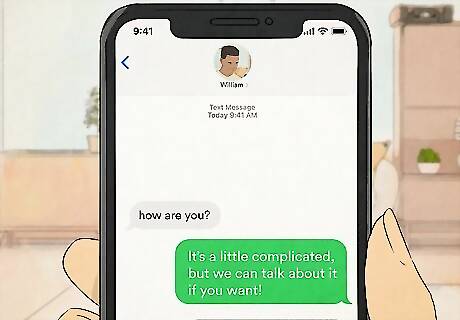
Give your texting partner the ability to decide where the exchange goes. That takes some of the pressure off of you in deciding how much or little to share, if you’re not sure. They’ll decide if they can respond to all of your worries and woes now, or if they’re a little busy and would rather hear it properly over a phone call later. “Could we talk about it in person later?” “It’s a little complicated, but we can talk about it if you want!” “Let’s do a phone call instead. It’s a long story!”
“I’m a little busy slaying dragons. You?”

Add some personality to your response to catch the other person’s attention. Even if you’re just coming up with another way to say “I’m fine,” you can do it with a flair by saying that you’re “slaying dragons” or “living the dream.” Use emoticons, text abbreviations, and whatever else you typically include in texts to make them feel like they’re your authentic thoughts. Whichever tone you choose to take in your response, make sure it has a personal touch to it. Don’t be afraid to sound goofy, or on the opposite end, too serious. Express yourself as honestly as you can, and the person texting you will appreciate it.
“Good question! Hmm, let me think...”

Read the situation before you reply. The tone and message of your response depends on who you’re talking to, so use your better judgement in each case. If you’re texting a work contact, your reply should tend towards sincere and professional. If you’re texting a friend, family member, or partner, then you have more options in your response: funny, clever, flirty, sincere, and so on. Ask yourself about who is texting you. Based on your relationship with them, is this someone who wants to know the nitty gritty details of your life right now? Or is this someone who is probably expecting a shorter and easier to navigate response? Let that answer determine your response. Think about yourself, too. If saying too much is going to put you in a bad mood, or otherwise affect your wellbeing, then it’s okay to decide you’re only going to give a short, simple answer.
“I’m well enough to chat, if you want to!”
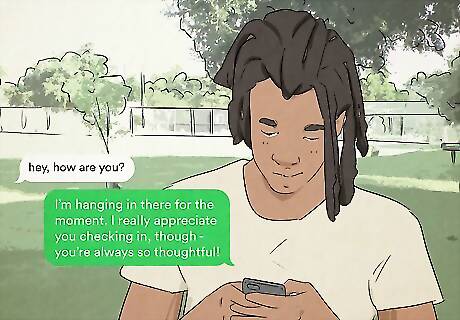
Set up a back-and-forth when you want to keep the conversation going. As we’ve seen, answering a “how are you” with “I’m fine” works in quick exchanges, but it doesn’t help with moving a conversation along. If you want to keep texting with this person, then formulate a response that will make them want to keep texting with you for a while. Ask them a question. The initial text gave you the opportunity to talk about yourself, so now, express interest in the other person. A good text conversation covers topics that both parties find engaging. Respond with, “All good here. What about you? Did you enjoy last night’s episode of [a television show]?” Pay them a compliment. Everyone likes to be complimented, and you can respond to their query with one. “I’m hanging in there for the moment. I really appreciate you checking in, though - you’re always so thoughtful!”
“Hey, great to hear from you! I was just thinking of you.”
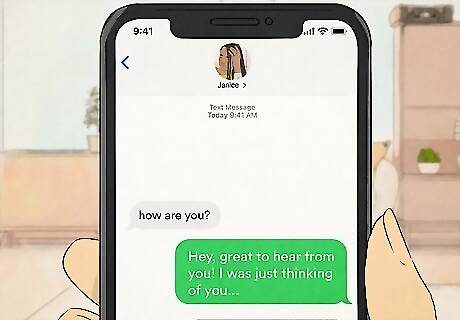
Use the text (and your response) to build up your relationship with this person. Texting can make communication more difficult, as you can’t read the facial and body language of the person you’re texting with, but it also has a lot going for it. In fact, texting makes communication easier for many people, because it gives you the chance to express yourself whenever you feel like it. When someone texts you to ask how you are, let them know that you’re thinking about them, too. “What a coincidence! I was just about to text you because…” “I’m doing well! I had actually been meaning to text you this funny photo I took the other day.” “Great, thanks! While we’re talking, could I get your opinion on something?”
“I’m fine, thanks.”
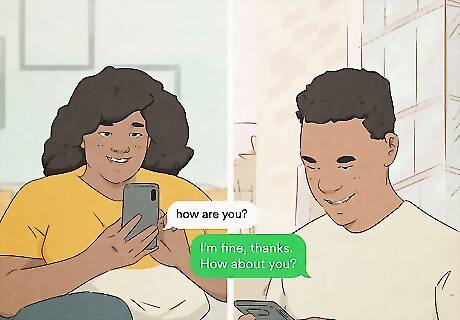
When in doubt, play it safe. Yes, the “I’m fine” response is considered basic, but it’s also appropriate to use in situations where you’re not sure what response you should give. If you can figure out the right message to send based on your relationship with the person texting you, great - but if it’s a more casual acquaintance or someone else you don’t text as often, it could be difficult to tell. In those cases, it’s better to be safe than sorry. Add a “how about you?” after responding. Even in cases where you’re not sure about your response, it’s a good idea to include this in your message. People like being asked questions, and you can also take a look at the other person’s answer. If it’s more personal, and you’re comfortable with responding in kind, then you’ll know for the future that you can be more open with this person.
















Comments
0 comment